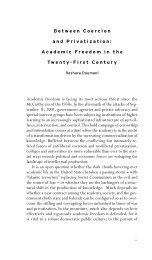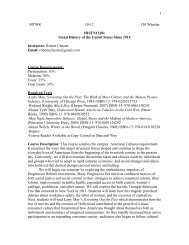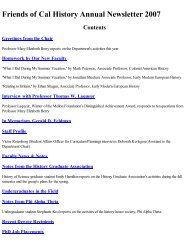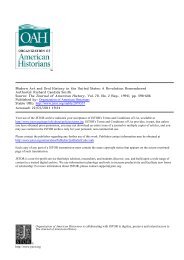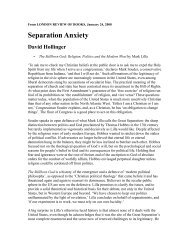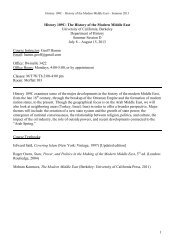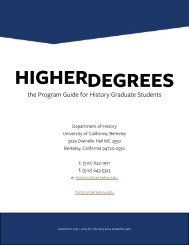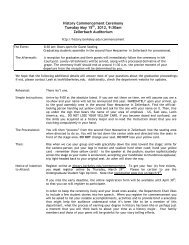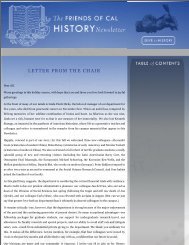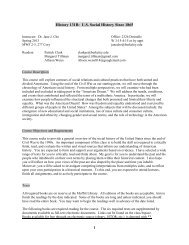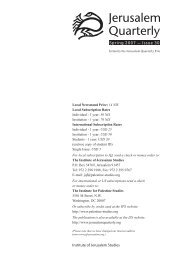David A. Hollinger | Amalgamation and Hypodescent: The Question ...
David A. Hollinger | Amalgamation and Hypodescent: The Question ...
David A. Hollinger | Amalgamation and Hypodescent: The Question ...
Create successful ePaper yourself
Turn your PDF publications into a flip-book with our unique Google optimized e-Paper software.
1 Ê Peggy Pascoe, "Miscegenation Law, Court Cases, <strong>and</strong> Ideologies of 'Race' in Twentieth-Century America," Journal of AmericanHistory 83 (June 1996): 64–65; Robert A. Pratt, "Crossing the Color Line: A Historical Assessment <strong>and</strong> Personal Narrative of Lovingv. Virginia," Howard Law Journal 41 (1998), as rpt. in Kevin R. Johnson, ed., Mixed Race America <strong>and</strong> the Law (New York, 2003),56–59.2 Ê Hannah Arendt, "Reflections on Little Rock," Dissent (Winter 1959): 79. This incident is analyzed by Werner Sollors, "Of Mules<strong>and</strong> Mares in a L<strong>and</strong> of Difference; or, Quadrupeds All?" American Quarterly 42 (June 1990), esp. 173–77.3 Ê Sidney Hook, New Leader, April 13, 1959.4 Ê An important example of open opposition to miscegenation laws during the 1960s was William D. Zabel, "Interracial Marriage<strong>and</strong> the Law," Atlantic (October 1965): 75–79.5 ÊLoving v. Commonwealth of Virginia, 388 U.S. 1; 87 S.Ct. 1817; 1967 U.S. Maryl<strong>and</strong> repealed its miscegenation statute just priorto the court's action. Fourteen states in the Far West <strong>and</strong> upper Middle West repealed their statutes between 1952 <strong>and</strong> 1966.6 Ê Polling data are reviewed in one of the most carefully detailed monographs yet addressed to the history of ethnoracial mixture inthe United States, Paul Spickard, Mixed Blood: Intermarriage <strong>and</strong> Ethnic Identity in Twentieth-Century America (Madison, Wis.,1989), esp. 192–93.7 Ê Martin Kilmjin, "Trends in Black/White Intermarriage," Social Forces 72 (1993): 119–46.8 Ê A. Leon Higgenbotham <strong>and</strong> Barbara K. Kopytoff, "Racial Purity <strong>and</strong> Interracial Sex in the Law of Colonial <strong>and</strong> AntebellumVirginia," in Werner Sollors, ed., Interracialism: Black-White Intermarriage in American History, Literature, <strong>and</strong> Law (New York,2000), 138–39. Higgenbotham <strong>and</strong> Kopytoff quote the South African minister of the interior's presentation to the assembly of thatcountry in 1949, in which the minister urges opponents of the proposed legislation to consider the fact that "thirty out of the fortyeightstates of the United States" have "found it necessary to take legislative steps" of exactly the sort he proposed for South Africa.9 Ê Sollors, "Introduction," Interracialism, 6. Sollors cites Heinrich Krieger, Das Rassenrecht in den Vereiningten Staaten (Berlin,1936).10 Ê Phillips's most famous utterance on this theme was his address on the Fourth of July, 1863, in Framingham, Massachusetts, inwhich he endorsed, <strong>and</strong> called by the name of "amalgamation," that "sublime mingling of the races, which is God's own method ofcivilizing <strong>and</strong> elevating the world." <strong>The</strong> history of the pre–Civil War discourse about amalgamation has recently been clarified byLeslie M. Harris, "From Abolitionist Amalgamators to 'Rulers of the Five Points': <strong>The</strong> Discourse of Interracial Sex <strong>and</strong> Reform inAntebellum New York City," in Martha Hodes, ed., Sex, Love, Race: Crossing Boundaries in North American History (New York,1999), 191–212.11 Ê Sidney Kaplan, "<strong>The</strong> Miscegenation Issue in the Election of 1864," in Kaplan, American Studies in Black <strong>and</strong> White: SelectedEssays, 1949–1989 (Amherst, Mass., 1991), 47–100. Kaplan's classic analysis of the "miscegenation hoax" was first published in1949. For a recent, authoritative study of the hoax <strong>and</strong> of the entire discourse about "amalgamation" <strong>and</strong> "miscegenation" during theantebellum <strong>and</strong> Civil War eras, see Elise Lemire, "Miscegenation": Making Race in America (Philadelphia, 2002), esp. 115–44.Lemire argues that the literary depiction of black-white intimacy helped create the very categories of black <strong>and</strong> white as thesecategories had come to be popularly understood in the United States by the time of the Civil War.12 Ê Even W. E. B. Du Bois used "miscegenation" interchangeably with "amalgamation" <strong>and</strong> "racial mixing." His learned essay of1935, "Miscegenation," intended for an encyclopedia but not published during his lifetime, is available in Sollors, Interracialism,461–73.13 Ê Philip Gleason, "<strong>The</strong> Melting Pot: Symbol of Fusion or Confusion?" American Quarterly 16 (Spring 1964): 20–46. Invocationsof the figure of the melting pot in our own time have largely forgotten the element of anti-Anglo aggression entailed in some of itsearly formulations. In the climactic scene of Israel Zangwill's play of 1909, <strong>The</strong> Melting-Pot, a major agent in the popularization ofthe concept, the Jewish immigrant hero envisages a future in which Mayflower descendants will be transformed in the fiery crucible<strong>and</strong> made equal to more recent immigrants from many l<strong>and</strong>s.14 Ê Among the few who did this was Zangwill himself, in a fleeting reference at the very end of his play in one of his lists of the



